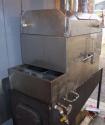
My largest flow over 24 hrs was roughly at your figure of .12 gal per tap per hour. However at the peak of flow I'm quite sure the actual flow was higher. Possibly closer to that .2 number.
2024 1520 taps Deer Run 500 RO with extra CDL post, Becker and CDL vac pumps. CDL Deluxe 3' x 12' oil fired
2023. 1300 taps Deer Run 500 RO, Becker vac pump, 2 Airtech vac pump, CDL Deluxe 3' x 12' oil fired
2022 1200 taps, Deer Run 500 RO, Becker vac pump, 2 Airtech vac pump
2021 650 taps, Deer Run 500 RO, 2 Airtech vac pump
2020 250 taps Airtech Vac pump













 Reply With Quote
Reply With Quote





